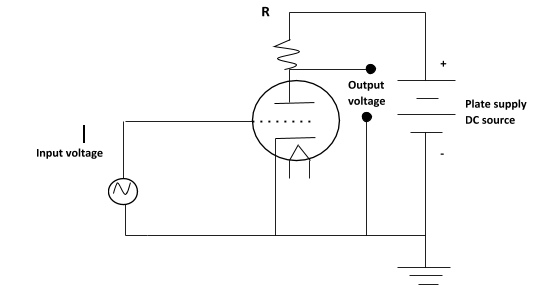Question
Question: When a triode is used as an amplifier the phase difference between the input signal voltage and outp...
When a triode is used as an amplifier the phase difference between the input signal voltage and output is:
A) Zero
B) π
C) π/2
D) π/3
Solution
The low-voltage AC signal connected between the grid and cathode alternately suppresses, then enhances the electron flow between the cathode and plate. This causes a change in voltage on the output of the circuit. The AC voltage and current magnitudes on the tube’s grid are generally quite small compared to the variation of voltage and current in the plate circuit. Thus, the triode functions as an amplifier.

Complete step by step answer:
We know that voltage gain A
A=μRL/(RL+rp)……………… (i)
rp =dynamic plate resistance
RL=Load resistance
µ= amplification factor
The amplification factor µ of a triode valve/vacuum tube is a measure of the relative effectiveness of the grid and anode voltages in producing the electrostatic fields at the surface of the cathode.
μ=−ΔVGΔVp
Substituting the value of μin eqn(i)
We get A=−ΔVG×(RL+rp)ΔVp×RL
Here,
ΔVp= change in phase voltage
ΔVG= change in grid voltage
The negative sign here shows that input voltage and output voltage are out of phase and out of phase means that the difference between the input voltage signal and the output voltage signal is 180 degrees and we know that in 1800=πradian.
Hence, Option (B) the correct answer.
Note: The triode valve or triode vacuum tube takes the basic concept of the diode and moves it on a significant stage further. A third electrode called a grid or more correctly a control grid is placed between the cathode and anode of the basic diode and by applying a potential to the grid, it is possible to repel or attract the electrons being emitted from the cathode and in this way affect the flow between cathode and anode of the triode vacuum tube.
